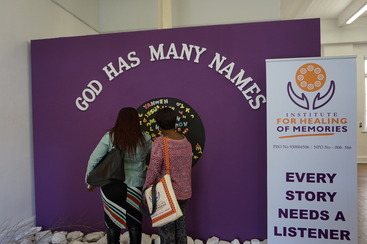Enhancing Life in the Aftermath of Collective Violence
April 28, 2016 • By Andrea Bieler
How do human beings seek to enhance life in the aftermath of atrocious violence? What kind of practices do they develop to learn again what it means to be human in the face of utmost experiences of dehumanization? What are the aspirations, values, and core beliefs that help or hinder victims, bystanders, and perpetrators in coming to terms with traumatic violence in a life-giving way?
I wrestle with these questions. I grew up in Germany in a post-genocidal society. Since I was a student I pondered the question: what does it mean to lead a meaningful life after Auschwitz? To be a citizen, a theologian, an intellectual, a person of faith?
I just returned from South Africa, where I learned more about the Institute for Healing of Memories, an organization founded by the Anglican priest Father Michael Lapsley in 1998, in the wake of the post-Apartheid era. I participated in a 10-day training for international leaders, introducing us to the philosophy and methodology of the Healing of Memory practice.

Photo courtesy of Mandla Nkosi
Let me begin with a brief historical sketch that led to the founding of the Institute. In 1994, the country’s first democratic election ended the political system of racial segregation in South Africa. For 46 years, Apartheid had deprived the majority of the non-White population of major civic and social rights. The Afrikaaner-led National Party perpetrated major human rights violations on people “classified” as Black, Colored, or Indian, inflicting horrendous pain and humiliation. Non-White political representation was abolished in 1970, and non-White people were deprived of their citizenship. All major areas of daily living were segregated: schools, health care, beaches. Interracial marriages were prohibited. Through systematic forced removals, about 3.5 million non-White South Africans lost their homes and were forced into segregated townships. Neighborhoods and friendships were torn apart. Men and women who resisted Apartheid became enemies of the state. Many were tortured, incarcerated, and killed.
Photo courtesy of Audrey Lukasak
There was only a small minority of Whites who felt imprisoned by the cocoon of White privilege that surrounded them. Among them was Michael Lapsley, a member of the Society for the Sacred Mission who was sent as a young priest in 1973 from New Zealand to South Africa to work as a university chaplain. Lapsley describes the process of his own dehumanization in a documentary about his life as follows: “When I arrived in South Africa I stopped being a human being and I became a white man; because from the moment of my arrival every single aspect of my life was decided by the color of my skin.”
Father Lapsley became an active participant in the Anti-Apartheid movement and eventually a member of the African National Congress (ANC). In 1976, he had to go into exile, first to Lesotho and later on to Zimbabwe, as the South African government pursued him. In 1990, after negotiations between the National Party and the ANC had already begun, he was the victim of a letter bomb that almost killed him. He survived, yet the blast destroyed both of his hands and one of his eyes. Scarred by this experience, he gradually transformed his purpose in life towards a ministry of healing.
When Apartheid as a political system was abolished, the newly elected government under the leadership of Nelson Mandela also saw the need to address forcefully the wounds and the trauma that were caused by Apartheid. They set out to engender processes of healing on various levels of social relationships and institutions. Between 1996 and 1998, the Truth and Reconciliation Commission (TRC) became a major platform. It offered a space for victims to share their stories and for perpetrators and bystanders to acknowledge their misdeeds and responsibility. The TRC focused on gross human rights violations such as torture and killings. However, it left untouched the enormous affliction and humiliation caused by systematic degradation and exploitation in the workplace, and by inferior education, police violence, and life in poverty.
After the TRC was concluded in 1998, Lapsley and others decided to open the Institute for Healing of Memories. They offer a workshop that is open to all South Africans who are willing to grapple with how the past has affected their individual lives, and to reflect on the major pain that affected their lives. The IHOM proceeds from the assumption that all South Africans were “messed up” by Apartheid. Henceforth, the political and spiritual task at hand is to restore a sense of common humanity that had been profoundly damaged by a distorted political logic that constructed racialized groups of people and created divisive hierarchies between them. As time went by, the IHOM began to offer workshops in various countries on the continent of Africa and beyond.
Photos courtesy of Audrey Lukasak
The Institute promotes particular forms of non-judgmental autobiographic story telling and collective acknowledgment of experienced pain, as well as ritualized expressions that support the release of poisoning memories.
These practices touch on deep feelings of abandonment, bitterness, shame, and guilt. However, the journey into the past is also directed towards the flourishing of life in the present and in the future. It taps into the human capacity to acknowledge the wounds and the scars that will remain, while simultaneously fostering a hope by rebuilding a shared sense of humanity. As such, it is fertile ground for theological reflection and religious creativity. Picturing divine pathos and action in relation to such experiences ─ as well as the future of involved communities and individuals – can be pivotal for myriads of people all around the globe who seek to find a path towards the flourishing of wounded life.
Read a Q&A with Andrea Bieler about her research here.
Top photo courtesy of Audrey Lukasak